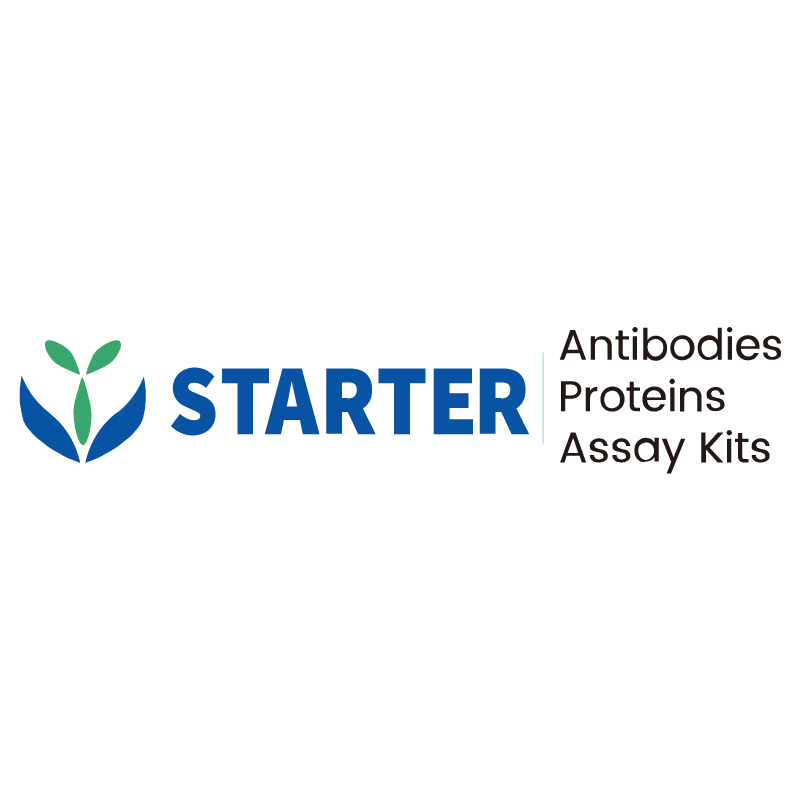WB result of UBASH3B/Sts1 Recombinant Rabbit mAb
Primary antibody: UBASH3B/Sts1 Recombinant Rabbit mAb at 1/2000 dilution
Lane 1: K562 whole cell lysate 20 µg
Lane 2: HepG2 whole cell lysate 20 µg
Lane 3: Jurkat whole cell lysate 20 µg
Negative control: K562 whole cell lysate
Secondary antibody: Goat Anti-rabbit IgG, (H+L), HRP conjugated at 1/10000 dilution
Predicted MW: 73 kDa
Observed MW: 68 kDa
Product Details
Product Details
Product Specification
| Host | Rabbit |
| Antigen | UBASH3B/Sts1 |
| Synonyms | Ubiquitin-associated and SH3 domain-containing protein B; Cbl-interacting protein p70; Suppressor of T-cell receptor signaling 1 (STS-1); T-cell ubiquitin ligand 2 (TULA-2); Tyrosine-protein phosphatase STS1/TULA2; KIAA1959 |
| Immunogen | Synthetic Peptide |
| Location | Cytoplasm, Nucleus |
| Accession | Q8TF42 |
| Clone Number | S-1307-5 |
| Antibody Type | Recombinant mAb |
| Isotype | IgG |
| Application | WB, IHC-P, ICC, IP |
| Reactivity | Hu |
| Purification | Protein A |
| Concentration | 0.5 mg/ml |
| Conjugation | Unconjugated |
| Physical Appearance | Liquid |
| Storage Buffer | PBS, 40% Glycerol, 0.05% BSA, 0.03% Proclin 300 |
| Stability & Storage | 12 months from date of receipt / reconstitution, -20 °C as supplied |
Dilution
| application | dilution | species |
| WB | 1:2000 | |
| IP | 1:50 | |
| IHC-P | 1:200 | |
| ICC | 1:100 |
Background
UBASH3B, also known as T-cell ubiquitin ligand 2 or suppressor of T-cell receptor signaling 1 (STS-1), is an atypical protein tyrosine phosphatase with a ubiquitin-binding domain. It plays a role in various cellular processes, including cell signaling, immune responses, and cellular development. In the context of cancer, UBASH3B has been implicated in tumorigenesis and cancer progression. Its abnormal expression is associated with the worsening of various cancers, and it may serve as a potential therapeutic target for inhibiting cancer growth. UBASH3B is also being investigated as a prognostic biomarker in prostate cancer, where its expression levels correlate with immune cell infiltration and overall prognosis. Furthermore, UBASH3B is involved in the regulation of immune responses, and its dysfunction has been linked to autoimmune diseases. It is expressed primarily in T-cells and has been associated with the regulation of T-cell receptor signaling.
Picture
Picture
Western Blot
IP
UBASH3B/Sts1 Rabbit mAb at 1/50 dilution (1 µg) immunoprecipitating UBASH3B/Sts1 in 0.4 mg HepG2 whole cell lysate.
Western blot was performed on the immunoprecipitate using UBASH3B/Sts1 Rabbit mAb at 1/1000 dilution.
Secondary antibody (HRP) for IP was used at 1/1000 dilution.
Lane 1: HepG2 whole cell lysate 20 µg (Input)
Lane 2: UBASH3B/Sts1 Rabbit mAb IP in HepG2 whole cell lysate
Lane 3: Rabbit monoclonal IgG IP in HepG2 whole cell lysate
Predicted MW: 73 kDa
Observed MW: 68 kDa
Immunohistochemistry
IHC shows positive staining in paraffin-embedded human tonsil. Anti- UBASH3B/Sts1 antibody was used at 1/200 dilution, followed by a HRP Polymer for Mouse & Rabbit IgG (ready to use). Counterstained with hematoxylin. Heat mediated antigen retrieval with Tris/EDTA buffer pH9.0 was performed before commencing with IHC staining protocol.
IHC shows positive staining in paraffin-embedded human spleen. Anti- UBASH3B/Sts1 antibody was used at 1/200 dilution, followed by a HRP Polymer for Mouse & Rabbit IgG (ready to use). Counterstained with hematoxylin. Heat mediated antigen retrieval with Tris/EDTA buffer pH9.0 was performed before commencing with IHC staining protocol.
IHC shows positive staining in paraffin-embedded human cervical squamous cell carcinoma. Anti- UBASH3B/Sts1 antibody was used at 1/200 dilution, followed by a HRP Polymer for Mouse & Rabbit IgG (ready to use). Counterstained with hematoxylin. Heat mediated antigen retrieval with Tris/EDTA buffer pH9.0 was performed before commencing with IHC staining protocol.
Immunocytochemistry
ICC shows positive staining in HepG2 cells (top panel) and negative staining in K562 cells (below panel). Anti-UBASH3B/Sts1 antibody was used at 1/100 dilution (Green) and incubated overnight at 4°C. Goat polyclonal Antibody to Rabbit IgG - H&L (Alexa Fluor® 488) was used as secondary antibody at 1/1000 dilution. The cells were fixed with 4% PFA and permeabilized with 0.1% PBS-Triton X-100. Nuclei were counterstained with DAPI (Blue). Counterstain with tubulin (Red).


